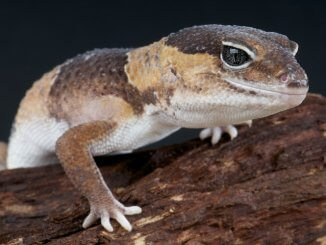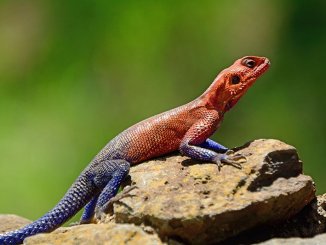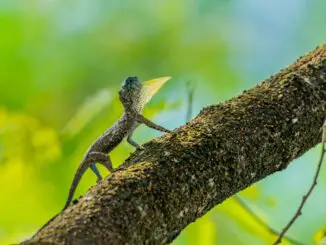The jeweled lacerta (Timon lepidus) is a species of lizard endemic to southwestern Europe, where it inhabits the bushy areas, open woodlands, coastal dunes, and vineyards of Spain, Portugal, Gibraltar, France, and Italy. The reptile grows up to 3 feet in length and is named for the distinctive, jewel-like markings spanning across its body.
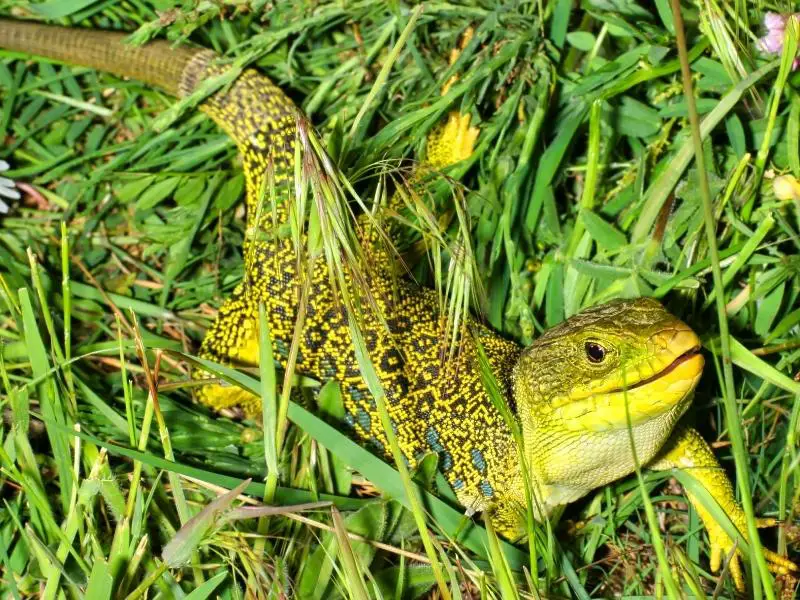
Jeweled lacertas are active, eyecatching, and generally peaceful, but they can be difficult to care for because they get stressed easily and require daily feeding.
Jeweled Lacerta Overview
| Common name | Jeweled lacerta, ocellated lizard, jeweled lizard |
| Scientific name | Timon lepidus |
| Natural habitat | Native to southwestern Europe. Bushy areas, woodlands, and coastal dunes |
| Adult size | Up to 3 feet |
| Average lifespan | 12–20 years |
| Diet | Omnivore (primarily insects) |
| Housing | A 4 x 2 x 3-foot enclosure with a humidity of 50% to 60% and a gradient temperature of 75 to 95°F, with a thick, pliable substrate, plants, climbing areas, and a humid hide |
| Experience level | Intermediate |
Origin
The jeweled lacerta (Timon lepidus) is native to southwestern Europe and can be found in open woodlands, scrublands, olive groves, vineyards, meadows, rocky areas, and coastal dunes.
These reptiles are near threatened and have declined significantly in population because of habitat loss, poisoning, and pesticide pollution.
The species has been protected in Spain since 2011, and capturing or selling wild jeweled lacertas is illegal. All specimens in the pet trade are captive-bred.
Appearance and Behavior
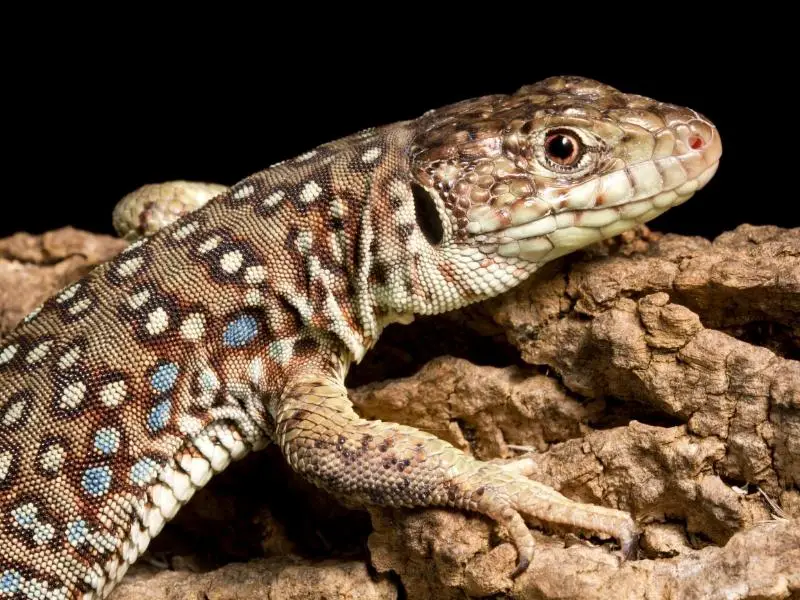
The jeweled lacerta is a large lizard with a serrated collar, muscular legs, long tail, yellow or green belly, and green, gray, or brown dorsum. The most defining characteristics of this species are its jewel-like blue spot patterning along its sides and the dark, interconnected rosettes that appear all over its body.
Males have broad heads and are larger and more colorful than females. Young jeweled lacertas have pale, black-edged spots.
Size and Lifespan
Female jeweled lacertas usually measure 16 to 20 inches from tail to head at full size, while males normally grow up to 24 inches. These lizards’ tails are extremely long and make up two-thirds of their total body length. Most jeweled lacertas weigh under 1 pound.
Jeweled lacertas live for 12 to 20 years if they’re fed a healthy diet and kept in ideal enclosure conditions.
Temperament
Jeweled lacertas are shy but active lizards that spend most of their time burrowing, basking, or exploring. While rarely aggressive toward humans, jeweled lacertas can be aggressive with one another, especially over food. Keep these reptiles in separate enclosures to prevent them from injuring one another.
Jeweled lacertas are skittish and prone to stress. They should only be handled when necessary, and their enclosure should be kept away from noisy, busy areas. These lizards may bite if they feel threatened or scared.
Signs of stress include open-mouth breathing, hiding, loss of appetite, and dull coloration.
Housing Jeweled Lacertas
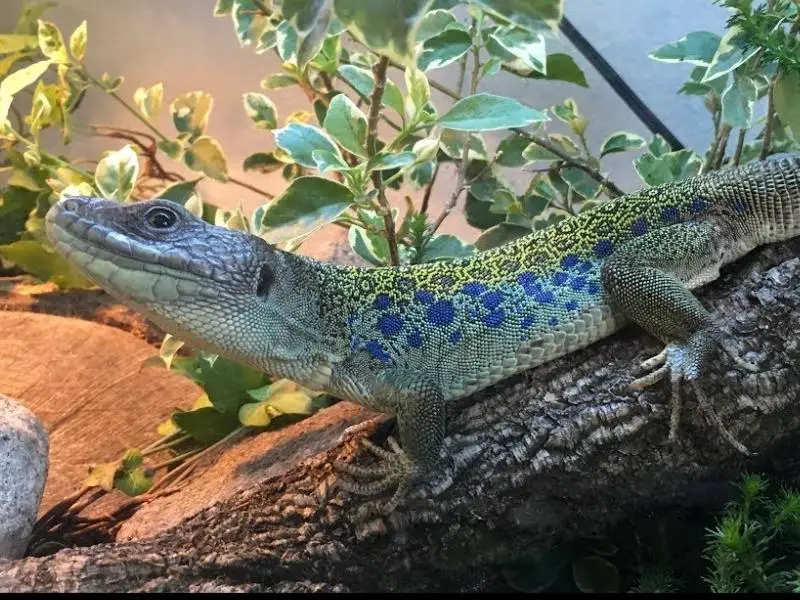
Jeweled lacertas are accustomed to dry, open areas in the wild. To simulate their natural habitat, keep jeweled lacertas in a vivarium with a temperature gradient of 95 to 75°F and a humidity of 50% to 60%.
These lizards are happiest when they’re provided with a pliable substrate, plenty of open space, a spot to bask, and lots of hiding spots.
Enclosure size
The jeweled lacerta requires a 20-gallon vivarium that measures 4 feet x 2 feet x 3 feet or larger. This size gives the lizard plenty of space to stretch out and explore.
Jeweled lacertas love to burrow and sometimes climb, so the vivarium must be tall enough to accommodate a thick substrate and climbing structure. Juveniles have been known to attack each other, so they should be kept in separate 20-gallon vivariums.
Opt for a front-opening vivarium to easily reach inside without startling the lizard.
Lighting
UVB lighting is vital for jeweled lacertas because it allows them to produce vitamin D3 and absorb calcium, which helps with bone development. Set up a UVB lamp on one side of the enclosure and provide 10 hours of light daily in the winter, and up to 14 hours of light during the summer.
Replace the bulb every 12 months.
Keep the light 8 to 15 inches above the basking area to prevent injury to the lizard and to ensure it receives the appropriate amount of UVB.
Temperature and Humidity
Jeweled lacertas are cold-blooded, so they need both hot and cool spots in the enclosure to properly regulate their body temperature. The basking area should be between 90 to 95°F, while the cool area should remain within 75 to 85°F.
If the UVB lamp doesn’t generate this heat, add a heating pad that has thermostat control. The enclosure’s temperature must stay above 72°F at night. Monitor temperature levels with high-quality digital thermometers.
Jeweled lacertas require a moderate humidity of 50 to 60%. Spray the enclosure lightly with water if the humidity gets low, and increase ventilation if humidity becomes too high. Use a hygrometer to check humidity levels.
The substrate should be sprayed a couple of times weekly to keep it moist but not soppy.
Jeweled lacertas are sensitive to fluctuations in temperature and humidity. If kept in the wrong conditions, these reptiles will become stressed and experience health problems like respiratory infections.
Incorporate a humid hide – a box with a moisture-holding substrate – to help these lizards regulate their temperature, and provide a large water dish for them to soak in when they’re shedding.
Substrate and Decoration
The substrate in the jeweled lacerta’s vivarium needs to be at least 6 inches thick to allow for burrowing and digging behaviors. Cocoa mulch and potting soil are ideal substrates for jeweled lacertas because these materials are soft, pliable, and hold moisture. Avoid substrates that are rough or restrict burrowing behavior.
Set up hiding spots and climbing areas in the enclosure with decorations like slate, driftwood, sterilized branches, artificial foliage, and cork bark. Spread decorations and hiding spots throughout the vivarium’s cool and warm zones.
Avoid any decorations with sharp edges or rough textures because these can harm lizards.
Add decorations first into the enclosure, then the substrate. Otherwise, the decorations can cause the substrate to compact or collapse, which can injure jeweled lacertas.
These lizards enjoy exploring their environment, so change the layout every few months to prevent boredom.
Cleaning
Cleaning the jeweled lacerta’s enclosure regularly helps to prevent a buildup of harmful bacteria. Remove waste and leftover food, replace soiled substrate, and top up the drinking bowl with fresh water every day.
Deep clean the vivarium every month. Remove and disinfect the decorations, replace the substrate, and spray the enclosure walls with water or a mild cleaning solution (avoid harsh chemicals like bleach).
Keep the jeweled lacerta in a separate enclosure of similar humidity and temperature levels while deep cleaning the lizard’s home enclosure.
Jeweled Lacerta Care
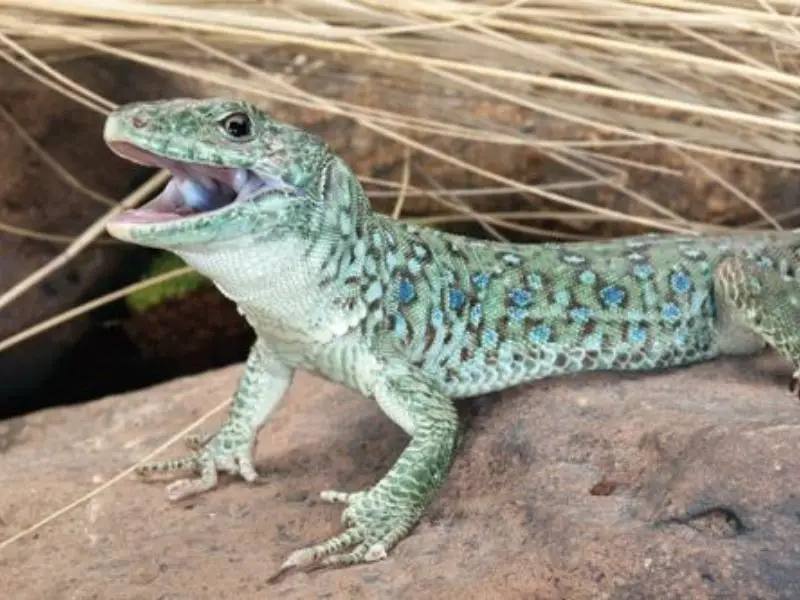
Jeweled lacertas are moderately difficult to care for because they can’t tolerate temperature or humidity changes, need daily feeding, and are prone to stress. With a nutrient-rich diet and vivarium that simulates their natural habitat, these reptiles live long and happy lives.
Food and Water
Jeweled lacertas are food-motivated omnivores that require daily feeding. In the wild, these lizards mainly eat invertebrates like insects and snails. Captive-bred jeweled lacertas should be fed a varied diet made up of crickets, Dubia roaches, super worms, silkworms, snails, and occasionally fruit (like strawberries and raspberries).
Offer jeweled lacertas as much food as they can eat within one sitting. Juveniles should be fed two newly-hatched crickets three to five times a week. Always buy captive-bred insects because those from the wild often carry toxic pesticides. The more food the lizard eats, the quicker it grows.
Add powdered calcium and D3 supplements to meals a few times a week to encourage the lizard’s healthy bone growth.
Replace the lizard’s water daily and disinfect the water bowl thoroughly if the jeweled lacerta soils the water. The bowl should be shallow and sturdy.
Handling
Handle the jeweled lacerta briefly, gently, and only occasionally because the lizard gets stressed easily. Handling often when the lizard is young helps it become accustomed to your touch. Start with short handling sessions, then gradually increase the duration.
The safest way to handle a jeweled lacerta is to put your hand underneath its body, then gently lift it. Support its body weight and feet with your palm and arm. Due to the lizard’s shy nature, avoid handling it in loud, busy, or social environments. Dimming the lights before handling the lizard can also help ease its stress and anxiety.
Jeweled lacertas rarely bite, but if they do, their bite won’t cause serious harm because the species is non-venomous and has small teeth.
Common Health Issues
Injuries caused by impaction (getting crushed under substrate) are common among jeweled lacertas because of their burrowing behavior, and can easily be prevented with a proper enclosure setup: stick to a pliable substrate, avoid heavy decorations, and always add the substrate last.
Other common health issues that affect jeweled lacertas include parasites, metabolic bone disease, and tail loss:
- Metabolic bone disease (MBD): Bones become soft, weak, and damaged. MBD is caused by an improper calcium-to-phosphorus ratio in the diet, and symptoms include skeletal abnormalities, bone fractures, and inactivity. Treatment involves dietary changes and supplements
- Parasites: Intestinal parasites can cause weight loss, poor appetite, diarrhea, abnormal stools, and vomiting in the jeweled lacerta. Parasites in jeweled lacertas are usually treatable with medication and can be prevented with regular deworming and keeping the enclosure clean
- Tail loss: Jeweled lacertas may drop their tail as a self-defense mechanism if they feel threatened or scared. Prevent tail loss by keeping stressors at a minimum and ensuring the lizard’s enclosure simulates its natural habitat. Always handle the lizard with care and never grab its tail
Hibernation
Jeweled lacertas hibernate when temperatures drop. During this period, the lizards cease activity and their appetite is significantly reduced.
Inducing hibernation in the jeweled lacerta’s enclosure isn’t necessary unless you’re looking to breed the lizards. To do so, slowly decrease the enclosure’s temperature to 50°F during winter.
Hibernation typically lasts for three months.
Breeding
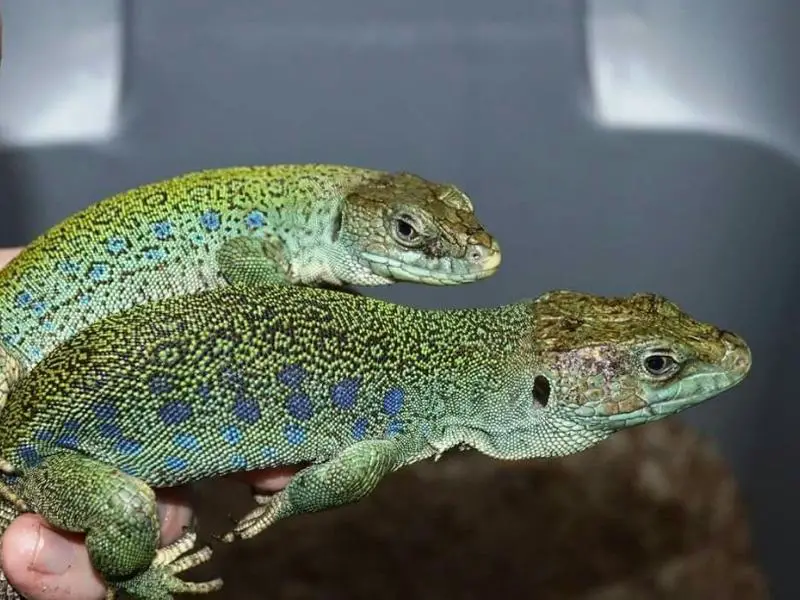
Breeding jeweled lacerta lizards are fairly difficult because of their aggressive nature and need to hibernate. After hibernation has been induced, mating will occur within a month.
- Set up a breeding enclosure that simulates the same environment as the lizard’s main enclosure. Add a nesting box for the female to lay her eggs in. The box should measure around 12 inches x 6 inches x 4 inches, and be filled with a warm, moist substrate (like damp soil)
- Ensure the breeding pair is healthy and well-fed before putting the lizards in the same enclosure because the mating process often gets violent. The male will chase the female around the vivarium and pin her down with his mouth once he catches her. Separate the pair temporarily if they become aggressive beyond this normal behavior
- The gravid (egg-carrying) female’s body will swell, and egg bulges may be visible. She’ll become restless, digging frequently, until she’s ready to lay her eggs
- Female jeweled lacertas lay their eggs within a few months of mating and produce 8 to 12 eggs on average, with up to four clutches in a single season
- Once laid, move the eggs immediately to a container inside an incubator with a temperature of 75 to 85°F for 80 to 120 days. Put vermiculite, an incubating substrate medium, in the container and keep it moist
- Check the eggs regularly for signs of hatching. Once the baby lizards start to emerge, leave them in the container for a couple of days, then move them to 20-gallon vivariums — four hatchlings per vivarium, and males separated from females
- Line the hatchlings’ vivariums with newspapers and paper towels, include plenty of hiding spots and keep a temperature gradient of 75 to 90°F. Provide up to 14 hours of light per day with a UVB lamp
Young jeweled lacertas should be fed newly-hatched crickets, and can move on to larger food when they’re of adult size. Feed hatchlings four to five times per week (two crickets per feeding) to encourage fast growth.
Choosing and Buying a Jeweled Lacerta
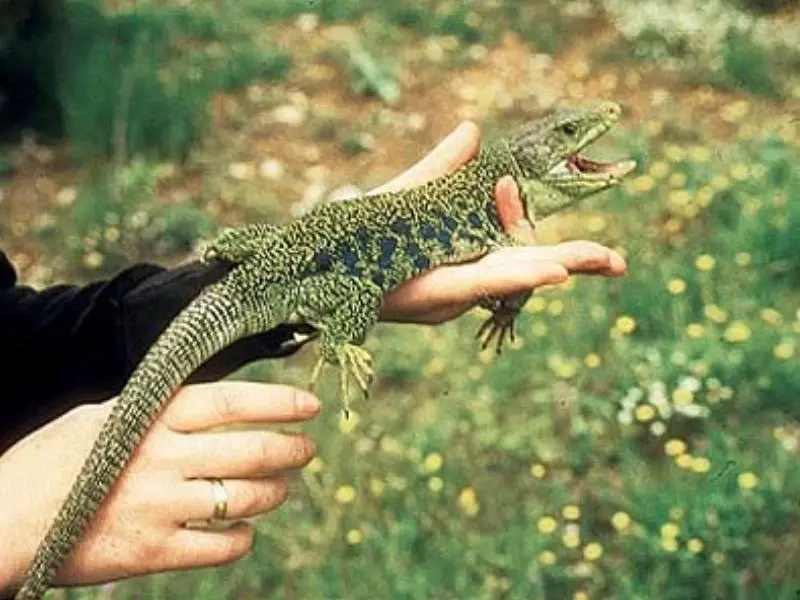
Jeweled lacertas are moderately expensive lizards, costing $80 to $200. While rare in pet stores, jeweled lacertas can be purchased from dedicated breeders and are sometimes available on online reptile stores.
A license isn’t required to own these lizards, though catching and buying wild jeweled lacertas is illegal. Always research the breeder before purchasing a jeweled lacerta to ensure the lizard has received proper care and has been captive-bred. Signs of a healthy lizard include alertness, bright eyes, tight skin, a firm jaw, and fat stomach.
With the right owner, the jeweled lacerta makes a wonderful companion and will keep you entertained with its lively personality and unique appearance.

